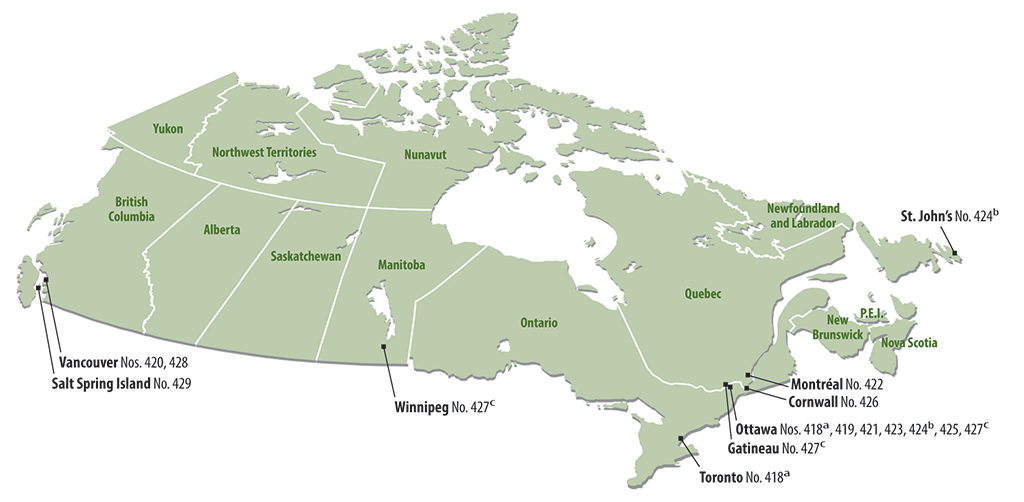
2019 Fall Reports of the Commissioner of the Environment and Sustainable Development to the Parliament of Canada Report 3—Environmental Petitions Annual Report
2019 Fall Reports of the Commissioner of the Environment and Sustainable Development to the Parliament of Canada Report 3—Environmental Petitions Annual Report
Table of Contents
Introduction
Environmental petitions process
3.1 The environmental petitions process is a unique way for Canadian residents to bring their concerns and questions about environmental issues to the attention of the federal ministers responsible and to obtain responses from them. It offers Canadians an opportunity to open a dialogue with their government. The Commissioner of the Environment and Sustainable Development administers the environmental petitions process on behalf of the Auditor General of Canada.
3.2 The Commissioner posts summaries of the environmental petitions received on the Office of the Auditor General of Canada’s website in the Petitions Catalogue. The petitions and departmental responses are available on request in the language in which they were submitted.
3.3 More details about the environmental petitions process are provided in the Appendix. The Office’s website also provides more information about the process, and about the roles and responsibilities of the Commissioner and of federal government departments and agencies.
Focus of the report
3.4 The purpose of this annual report is to inform Parliament and Canadians about the number, nature, and status of petitions and responses received between 1 July 2018 and 30 June 2019, as required by section 23 of the Auditor General Act.
2018–19 Results
Petitions received
3.5 The Office of the Auditor General of Canada received 12 environmental petitions between 1 July 2018 and 30 June 2019. The petitions, numbered 418 to 429, originated from 5 provinces: British Columbia, Manitoba, Newfoundland and Labrador, Ontario, and Quebec (Exhibit 3.1).
Exhibit 3.1—Petitions came from 5 provinces between 1 July 2018 and 30 June 2019

British Columbia
420—Federal financing of the Fraser Surrey Docks coal export terminal and other coal export facilities
428—Ten requests to the Government of Canada for improving the well-being of the environment
429—Plastic pollution in our oceans
Manitoba
427note c—Nuclear governance problems in Canada
Newfoundland and Labrador
424note b—Petition for clarification on the conversion of Western Brook Pond Trail to a gravel access road in Gros Morne National Park
Quebec
422—Results of wheat, oats, and corn sampling for glyphosate by the Canadian Food Inspection Agency
Ontario
418note a—Need for a national policy on decommissioning of nuclear reactors
419—Concerns about investment in “new” nuclear technologies
421—Questioning nuclear power as clean energy
424note b—Petition for clarification on the conversion of Western Brook Pond Trail to a gravel access road in Gros Morne National Park
425—Public transit, municipal priorities, and federal government intervention
426—Canadian Coast Guard Aids to Navigation discarded batteries
Source: Petitions submitted to the Auditor General of Canada. Summaries are available on the Office of the Auditor General of Canada’s website.
Exhibit 3.1 map—text version
This map of Canada shows the communities from which the petitions came during the period from 1 July 2018 to 30 June 2019. Petitions came from 5 provinces: British Columbia, Manitoba, Ontario, Quebec, and Newfoundland and Labrador.
British Columbia
- Salt Spring Island: Petition 429
- Vancouver: Petitions 420, 428
Manitoba
- Winnipeg: Petition 427
Ontario
- Toronto: Petition 418
- Ottawa: Petitions 418, 419, 421, 423, 424, 425, 427
- Cornwall: Petition 426
Quebec
- Gatineau: Petition 427
- Montréal: Petition 422
Newfoundland and Labrador
- St. John’s: 424
Notes:
- Petition 418 was jointly submitted by petitioners from Ottawa and Toronto, Ontario.
- Petition 424 was jointly submitted by petitioners from Ottawa, Ontario, and St. John's, Newfoundland and Labrador.
- Petition 427 was jointly submitted by petitioners from Winnipeg, Manitoba; Ottawa, Ontario; and Gatineau, Quebec.
Source: Petitions submitted to the Auditor General of Canada. Summaries are available on the Office of the Auditor General of Canada’s website.
3.6 This year, 12 federal departments and agencies received petitions. In many cases, a petition was sent to more than 1 department or agency. The 5 organizations that received the most petitions were
- Environment and Climate Change Canada—petitions 419, 420, 421, 425, 427, 428, and 429
- Natural Resources Canada—petitions 418, 419, 420, 421, 427, and 428
- Transport Canada—petitions 420, 425, 426, and 428
- Department of Finance Canada—petitions 419, 420, and 428
- Health Canada—petitions 422, 423, and 428
3.7 Key issues raised. The petitions addressed a wide variety of issues, including concerns about nuclear energy and the nuclear industry in Canada (petitions 418, 419, 421, and 427) and the use of the herbicide glyphosate (petitions 422 and 423). Concerns about national parks, hazardous waste, and plastic pollution in the oceans were among the issues raised in other petitions.
3.8 In some instances, the federal government has addressed and taken action on issues raised in environmental petitions. For example, petition 417, submitted in May 2018, raised concerns about a proposed new biking and walking trail parallel to the Icefields Parkway in Jasper National Park. The petition questioned the rationale for the project in light of Parks Canada’s priorities. Although we could not make a direct correlation between the petition and Parks Canada’s subsequent actions, we noted that in January 2019, the agency announced that the proposed trail would not proceed, given the “concerns expressed over the potential environmental impact and high cost associated with the project.” The $65.9 million set aside for the project in Budget 2016 would be reallocated to Parks Canada’s other priorities.
Performance and responses of departments and agencies
3.9 This reporting year, 10 departments and agencies responded to 9 petitions submitted during the current (2018–19) and previous (2017–18) reporting periods. All of the petition responses were provided within the 120-day statutory deadline.
Administration of the environmental petitions process
3.10 Changing our approach to submitting and publishing petitions on our website. We have created an online submissions form to make it easier for Canadians to submit petitions. We have also streamlined the explanatory materials on petitions that are available on our website. To meet our legal obligations and other guidance from the Government of Canada, we have also made a few changes to the Petitions Catalogue. Information about petitions submitted over the past 15 years is available on request.
3.11 Communicating the petitions process to Canadians. We continue to use a variety of communications products to raise Canadians’ awareness of the petitions process. We have reached out to various organizations to provide information about the petitions process, answer questions, and provide advice on submitting a petition. For example, our staff delivered presentations on the petitions process to several university classes and to an international conference focused on Arctic issues. We have also continued our outreach to Indigenous organizations in Canada.
3.12 Improving how we help Canadians. We continue to survey petitioners after they receive responses from departments and agencies. By completing the surveys, petitioners can assess and comment on the responses, and they can opt to have their comments provided to the officials from those departments and agencies. In addition, the Office of the Auditor General of Canada considers petitions and the related responses when developing its multi-year performance audit program.
3.13 Improving how we help federal organizations. We continue to provide guidance to federal officials who respond to petitions and answer petitioners’ questions. We provide feedback to departments and agencies on petitioners’ survey responses regarding the level of petitioner satisfaction.
Period covered by the report
This report covers the period between 1 July 2018 and 30 June 2019.
Petitions team
Principal: Kimberley Leach
Director: George Stuetz
Perla Hernandez
Roxanne Lepage
Kris Nanda
Jason Waters
Appendix—About the environmental petitions process
The environmental petitions process and the role of the Commissioner of the Environment and Sustainable Development
Environmental petitions process
Starting a petition
A Canadian resident submits a petition to the Auditor General of Canada. The petition can be submitted via the new online submissions form on our website, or it can be submitted by letter, fax, or email.
Reviewing a petition
The Commissioner reviews the petition to determine whether it meets the requirements of the Auditor General Act.
If the petition meets the requirements of the Auditor General Act, the Commissioner will
- determine which federal departments and agencies may be responsible for the issues addressed in the petition
- send it to the ministers responsible
- send a letter to the petitioner, listing the ministers to whom the petition was sent
If the petition does not meet the requirements of the Auditor General Act, the petitioner will be informed in writing.
If the petition is incomplete or unclear, the petitioner will be asked to adjust the petition and resubmit it.
Responding to a petition
A minister who receives a petition must
- send a letter within 15 days to the petitioner and the Commissioner, acknowledging receipt of the petition
- consider the petition and send a reply to the petitioner and the Commissioner within 120 days
Ongoing petition activities
Monitoring
The Commissioner monitors acknowledgement letters and responses from ministers.
Reporting
The Commissioner reports to Parliament on the petitions and responses received.
Posting on the Internet
The Commissioner posts summary information of each petition on the Internet in both official languages.
Auditing
The Office of the Auditor General considers issues raised in petitions when planning future audits.
Outreach
The Commissioner carries out a variety of outreach activities to inform Canadians about the petitions process.
